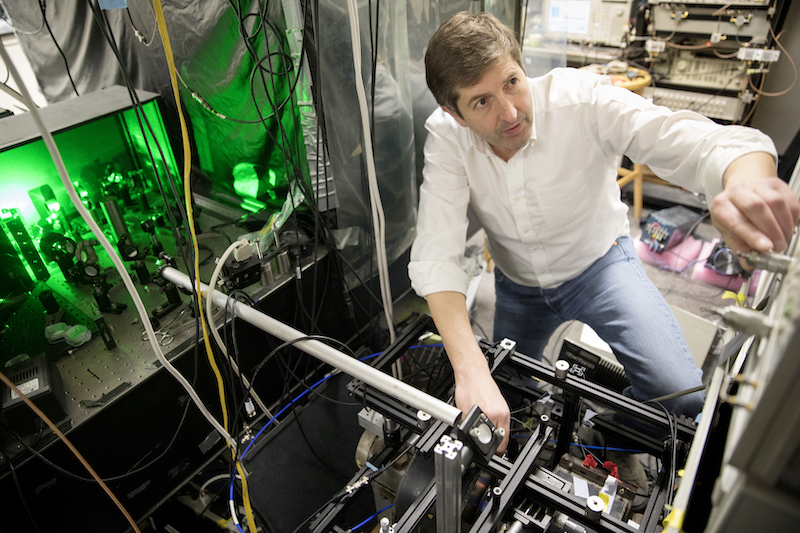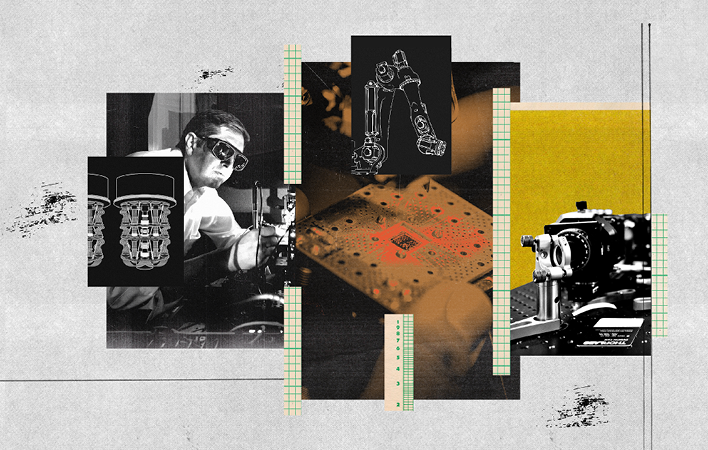"Humans have been fabricating things with, essentially, one hand tied behind our backs,” says Professor Ronald Walsworth, who has made it his mission to unleash our quantum potential. As founding director of the Quantum Technology Center (QTC), a joint collaboration of Maryland Engineering, UMD’s Department of Physics, and the U.S. Army Research Laboratory, Walsworth and his colleagues are working to harness the capabilities of quantum physics—the study of the smallest building blocks that make up our world: electrons, photons, protons, and quarks—to develop a powerful new generation of technologies with wide-ranging, real-world applications.
Quantum research at UMD, Walsworth says, could help create better biomedical diagnostics, assist with early-stage disease discovery and therapeutics, enable more energy-efficient batteries, and solve major optimization problems in manufacturing, healthcare, and other industries.
“Quantum physics is at the core of everything in our universe,” says Walsworth, a Minta Martin Professor of Electrical and Computer Engineering and Physics. “Whether you’re doing something in civil, mechanical, or electrical engineering, there are quantum effects.”
You’re a precision measurement physicist who spent years in the biomedical space; you’re now an engineering faculty member working to translate quantum research into innovative technologies. How do you explain your career trajectory?
It’s been very satisfying to work across disciplines; I get to go up the learning curve in various fields of science and engineering. At the beginning, you don’t know enough. When you’re an expert, you tend to know all the reasons why something isn’t possible—you stop dreaming. It’s when you’re about halfway up a learning curve that you often have your best ideas: you know enough to contribute, but you’re still learning. Like a 12-year-old kid, you can have dreams of what might be possible.
You joined UMD in 2019. What makes College Park the ideal environment for your work?
We have a vital, growing quantum community here at a top state university. UMD’s Joint Quantum Institute, one of the world’s most well-known and successful institutes for basic quantum science, has been here for almost two decades. This led to IonQ, the publicly traded quantum computing company that spun out of College Park Professor Chris Monroe’s lab.
The university is intentional about being a leader in all areas of quantum technology. Hence the motto of QTC: innovate, translate, educate in quantum. At QTC, we make a conscious effort to connect with work across all of engineering and other units on campus. QTC being located in both the IDEA Factory and soon in Zupnik Hall is going to be great; we very much look forward to interacting there with our colleagues across multiple disciplines.
How can quantum technology build a better world?
In the 20th century, we began to understand that the universe is quantized, that nature is discrete. We developed some important technology, like semiconductors, lasers, and MRI medical imaging, that depend on exploiting quantum physics. The atomic clocks that orbit Earth inside satellites, and send back the signals that enable GPS systems, rely on quantum physics.
But these 20th century technologies are still somewhat crude. They use large numbers of quantum objects in a rough way—we’re not taking advantage of all of their quantum properties. With progress in the last couple decades, we can now control each quantum object individually and how they interact with each other, which opens up amazing new possibilities.
For example, existing classical computers cannot calculate quantum mechanics efficiently enough to know which molecular configurations are optimal, e.g., for a life-saving new drug. Instead, chemists pursue a time-consuming and expensive process of trial and error to synthesize thousands of variations of molecules, until eventually, maybe, they find the right one.
Quantum computers may solve this bottleneck and greatly speed up the discovery of new drugs. How? Quantum computers calculate in a fundamentally different way: They use the laws of quantum mechanics, essentially a large interference experiment, set up to lead to the optimal answer. With a quantum computer (and this remains to be fully realized), we could determine optimal molecular configurations for new therapies—and likely for a wide array of other purposes, like more efficient batteries.
Quantum computers may also solve complex optimization problems, allowing humans and machines to operate with much less environmental impact. What, for example, is the optimal way to move things around the world? Shipping, commuting, and so forth? You probably know the optimal way to walk from your house to your neighbor's: there’s only one direct path. However, if you are delivering millions of different objects from thousands of different fabrication facilities to millions of different locations, the optimal path is a very hard question. If you do it more efficiently, enabled someday by calculations done by quantum computers, we can accomplish the same goal with much less energy, much less time, and at much lower cost.
What does diversity, equity, and inclusion look like in the quantum pipeline?
We try to provide educational and research opportunities that account for the full range of human experience and identity: as one example that is becoming increasingly appreciated, the different realities people have with their physical and mental health (this was somewhat informed by my son’s experience being diagnosed with and recovering from a brain tumor). So, we adjust quantum training programs and courses based on the individual’s situation.
For instance, we’ll often have a group of students working collaboratively on a quantum research project. One student may have a health or other issue that limits their ability to work in the lab, so this student might do more of the calculations and simulations, and the other students might do more laboratory work. Building a sense of community, where we’re all working together and helping each other, helps grow and diversify the quantum pipeline.
Back to Landing Page


